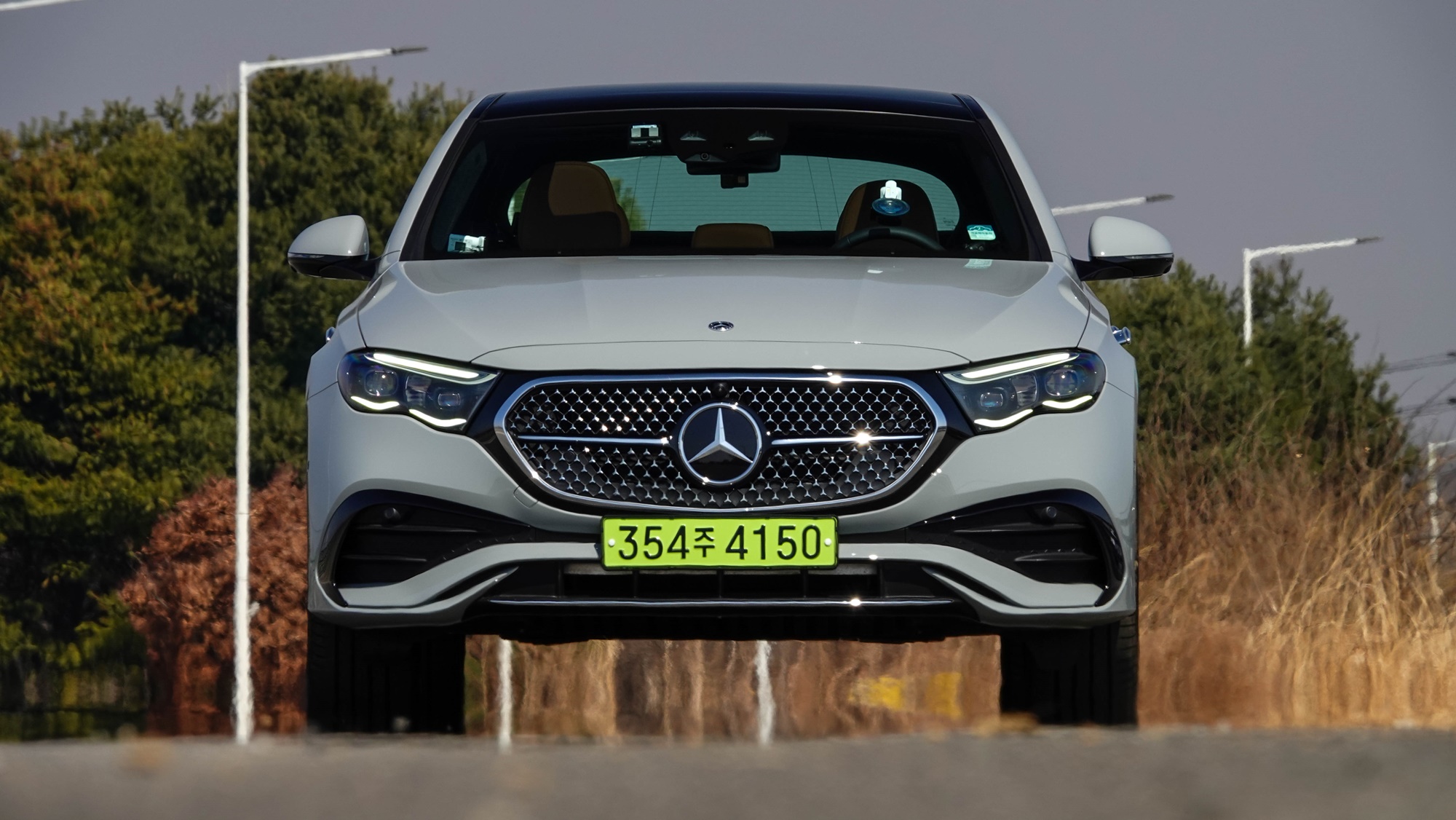
The 11th generation E-Class has made its debut as a complete redesign after 8 years. It is the core model that corresponds to the backbone of Mercedes-Benz. It represents the upper limit for owner drivers, as anything beyond that leads into the realm of chauffeured vehicles.
It exhibits remarkable stability. The agility suspension and all-wheel drive system elevate the perception of softness and firmness to a high level. Driving an E-Class is a luxury enjoyed by those who are socially stable.
The car’s stability becomes more pronounced when driving at high speeds, allowing for even faster travel due to its steady posture. It moves most elegantly, yet when needed, it can perform rapid movements quite gracefully as well.
The design of the E-Class has three variations. It includes the similar Avantgarde and Exclusive, as well as the AMG Line that features AMG design elements on the Avantgarde. The test vehicle provided by Mercedes-Benz Korea was the E300 4MATIC AMG Line. Its front overhang is short, while the long hood gives it a striking appearance. The cab has a backward position for the A-pillar, achieving a unique design.
The radiator grille is densely filled with star patterns. The large Mercedes emblem in the center, along with the chrome borders, attracts attention. The headlamps are adequately bright and intelligent. The digital light, standard on the E300 4MATIC and above, boasts a resolution of over 1 million pixels per lamp. It optimizes brightness based on traffic conditions, weather, and road status, ensuring greater visibility. Night driving will undoubtedly be more comfortable.
The MBUX infotainment system has evolved into its third generation. The content has become richer, allowing internet connectivity and access to video services like YouTube. A monitor known as the MBUX Super Screen has been added in front of the passenger seat. This ensures that passengers will not get bored during the journey. Additionally, the privacy function prevents the driver from seeing the passenger screen, meaning they won’t be distracted while driving.
The sound resonance converter (exciter) is installed in the driver and passenger seatbacks. When music is played, the seats vibrate and respond in rhythm with the tune. This sensory experience is part of the Burmester 4D surround sound system, allowing music to be felt through the seats. With 17 speakers positioned throughout the interior and an audio system that outputs 730W, including Dolby Atmos capabilities, the audio experience is astonishing.
A camera is positioned centrally at the top of the dashboard facing the interior. When connected to a storage device via USB, it’s possible to record and take pictures of the cabin using this camera, even allowing for video conferencing while parked. It’s a convenient feature, although some may have concerns about hacking.
It is paired with a 2.0-liter inline 4-cylinder gasoline engine (M254) and a 9-speed automatic transmission, with a 48V mild hybrid system added. It produces a maximum output of 258 horsepower and a peak torque of 40.8 kgm.
At 100 km/h, the engine runs at 1,200 rpm. This is the engine speed that showcases the efficiency of the 9-speed transmission. It can comfortably cover 100 km/h without raising the rpm. Of course, if the gear count is lowered, it can rise to 4,700 rpm in 3rd gear, creating a crisp sound.
The sound produced during acceleration in sports mode is alluring. It’s a sporty engine sound that urges you to keep pressing the accelerator. The impression of stability at high speeds, achieved by the supple yet firm suspension and all-wheel drive, is indeed remarkable. The perceived speed is significantly less than the actual speed.
A drag coefficient of 0.23 is impressive. The unique and sleek body cuts through the air. This reduction in wind resistance reduces noise and fuel consumption.
The car monitors three lanes around your lane, differentiating between large and small vehicles. It includes a lane change assist feature. When the turn signal is on, it considers speed and the situation ahead and behind to assist in lane changes. Out of ten attempts, it succeeds about two or three times. It operates only in conditions conducive for beginner drivers to change lanes with ease.
This car falls under the ‘low-emission vehicle 2 type’ classification. This brings benefits such as exemptions from urban congestion charges and reductions in public parking fees, providing a little unexpected joy from time to time.
You can use digital keys through your iPhone and Apple Watch. This allows you to start the engine and lock the car doors. Up to 16 people can share this digital key.
The time taken to accelerate from 0 to 100 km/h was 6.92 seconds. The record on the specification sheet is 6.1 seconds. On a route from Paju to Seoul covering 55 km, with 5 km of that in urban driving conditions, real driving fuel efficiency was assessed. The official fuel economy is 11.6 km/L, while the actual driving economy recorded was 14.3 km/L. The selling price of the E300 4MATIC AMG Line is 93.9 million won, while the Premier Special model costs 100.52 million won.
It is a high-quality business sedan with remarkable stability. Once again, it confirms that it is the pinnacle choice for owner drivers who enjoy driving themselves.
Joong-Hoon Oh’s candid comments
The exposed metal of the trunk is unappealing. It’s hard to understand why, in a car costing 100 million won, they would cut corners on trunk finishing materials. It falls short of the expectations of consumers who place value in the Mercedes E-Class.
The rear seat space is sufficient, allowing about two fists worth of space in front of the knees, yet there is a strong psychological pressure as if the space is tightly filled. The center tunnel is high, and the top part of the front seats tilts backward, psychologically constraining the space.
Joong-Hoon Oh: yes@autodiary.kr
